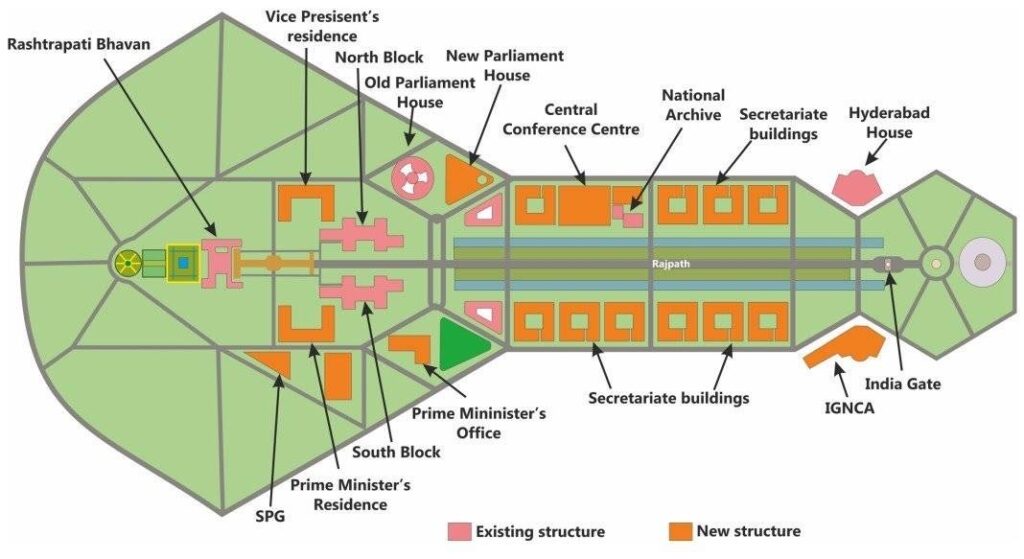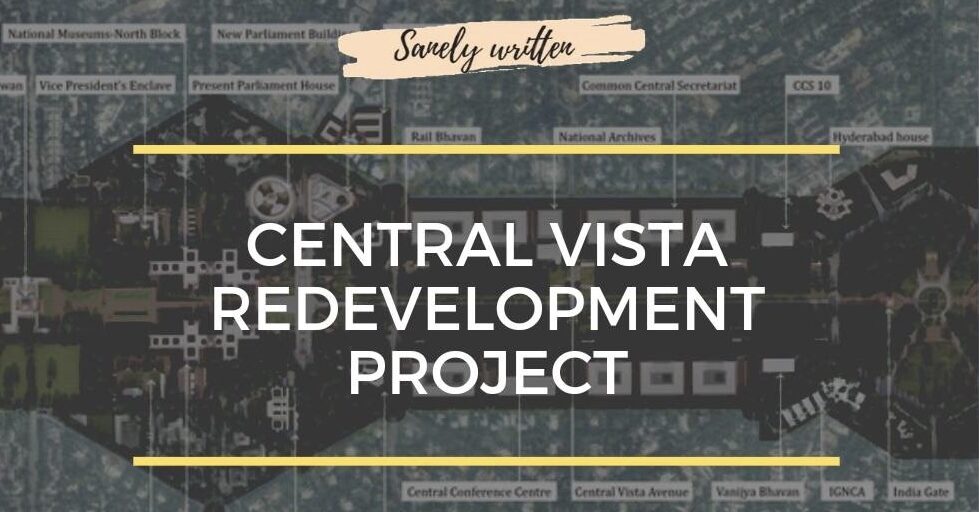Pointing out the flaws in government’s policies or in the government itself is a fundamental practice in democracy. The opposition party must raise their voice in the parliament which will force the government to double-check their work. But sometimes it gets uncomfortable to speak when you are sitting on plastic chairs in closed confined settings, with no place to keep the documents and mics that cannot be turned off (some need to close the mic and ask as to what they have to speak now). These things certainly are not dignified for the Parliament of the largest democracy of the world. We’ll get to the part where we talk about the things mentioned just now but before that, we need to understand the whole ruckus about the Central Vista Project.
The Central Vista:
Let us understand some terminology. The Central Vista or the Central Vista Avenue is the 3 km stretch between the Rashtrapati Bhawan and the India Gate located in Raisina Hills, New Delhi. Often termed as the Power corridor, this is the place where business takes place. It won’t be wrong to term it as the office space of the country. This is the place where each and every important government building is located. The Rashtrapati Bhawan, the Parliament, offices of the Prime Minister and all other ministries. The area was designed by Edwin Lutyens and Herbert Baker for the British Government in India and is also known as Lutyens’ Delhi. Often termed as “the best-kept secret in the history of India”, the capital of British India was shifted from Calcutta to Delhi on December 12, 1922. King George V while laying the foundation stone on December 15, 1911 “set the tone” for the planning and designing of the city to be in every way worthy of the ancient city. Lord Crewe, the Secretary of State for India said, “the new capital should underscore the permanency of British sovereign rule over the length and breadth of the country”.
In 1947 after the “transfer of power” from the British, this area was taken over and was considered the seat of the Government of India. Since then this region has been the centre of Power. Now the Central Vista Redevelopment Project aims to rebuild certain structures in the avenue and refurbish some and the government has its reasons.
The Central Vista Redevelopment Project:
The Project has two major parts and one not so major. The major parts include a new Parliament building adjacent to the present one and a new secretariat building that will act as a hub for all the central government ministries. The not so major part includes the development of the Rajghat and the area around it. The Sansad Bhawan which is presently serving the government of India may look like a 7-star hotel from the outside but over the years it has been deteriorating and is no longer in a state to serve the country. The same goes with the present secretariat building or the North and South blocks.

Source: HCP
The new Parliament building is in no doubt the highlight of the whole project. It will be a triangular structure next to the old Parliament building in order to make the most use of the triangular plot that currently serves as a parking lot for the old one. The new structure will have a Lok Sabha with 876 seats but can accommodate 1350 persons at a time, a Rajya Sabha hall with 400 seats, a Lounge around a courtyard, and a central space called the Constitution gallery. It will not have a Central Hall for joint sessions because the Lok Sabha Hall will have enough capacity to hold members of both houses at the same time. Now there is an urgent need for a Parliament with more seating capacity and it has something to do with the increasing population of the country. We’ll explain.
It was decided that the number of MPs in a state will be changed every ten years in order to reflect the change in population so that every MP will reflect a number of citizens. An idea was formulated in the 70s as a policy of population control but the issue arises that if a particular state is unable to check the population then more seats will have to be allocated to that particular state. Due to this concern, the idea to change the number of seats was frozen in 1976 for the next 25 years and again in 2001, it was shifted for another 25 years. So now the same is to be exercised in 2026 which is just a few years away. The population of the country is still increasing and shifting it for another 25 years is not such a good idea. It is speculated that now the government is planning on an increase in the Lok Sabha seat from 543 to more than 800 but the present Parliament building is not in any state to hold such a large number of people in the Lok Sabha hall. There have been many temporary measures taken over the years to accommodate the members in the Hall.
Plastic chairs are used by the members to sit during a joint session of both the Houses. There is not enough space for the members to sit comfortably. Apart from the first two rows, there is no desk for the members to keep their important documents. The infrastructure of the building is deteriorating. It looks flamboyant from outside but several drillings in the building for electrical and telecommunication lines, sewage pipes etc have weakened the structure. The electronic voting system is very old and the microphones cannot be switched off.
The area around Delhi has become earthquake-prone in the past few years and the design of the building is very old and also the original copy is not available which makes it difficult to check whether the building is earthquake-proof or not. There is no separate lounge area in the central hall which serves as a place for important discussions on policies and bills in an informal setting outside the house sessions. Two extra floors had to be added at the top of the building for office purposes. The building is in a complete mess with close compacted spaces, depleting infrastructure, old and poor technology and an earthquake-prone site.
A disordered and incoherent development on either side of the central vista has led to major mismanagements in parking facilities, traffic and public movement. The symmetrical design which was originally formulated by Lutyens and Baker is thrown completely out of the window and “Hutments” or non-essential buildings have been developed in the region. Over time as the population in the city started increasing, resources fell short and the city also started increasing but in complete disarray and mismanagement. Spaces were too confined which resulted in heavy traffic. Out of the total 51 ministries in the Union government, only 22 are located inside the central vista and the rest are scattered all around the city. Around 41,000 of the total 51,000 employees are inside the central vista and around 10,000 outside. This results in extra traffic movement in the city and waste of time in any inter-ministerial work. Many government offices are located in different parts of the city in rented buildings which costs an extra 1000 crore to the government.
Due to this, the Central Vista Redevelopment Project aims at developing a central secretariat where all the ministries will be located inside the avenue. Defence buildings and army barracks will be moved out. The secretariat building will include a total of 10 identical rectangular doughnut-shaped buildings located on either side of the Rajpath. None of the buildings will be taller than the India Gate. It will also include a Conference Hall and a National Archives building. There will be a large courtyard in the middle of the buildings and trees will be planted. The outside of the buildings will be constructed to match the original Lutyens’ buildings but the interiors will be covered in glass and steel. The secretariat building is a complex structure with an underground transit. There will be a shuttle service beneath the buildings connecting the different ministries in a rectangular transit path which will eliminate the use of vehicles in the avenue.
Currently, the Prime minister’s residence is located outside the central vista in 7, Lok Kalyan Marg. It will also be shifted in the avenue in front of the Rashtrapati Bhawan on the south of the South Block. Just opposite the PM residence, there will be the Vice-president’s residence on the north of the North block. These buildings will be identical keeping in mind the symmetry of the vista. The PMO will be built on the east side of the PM residence on the diamond-shaped plot. SPG facility will be available next to the PM residence. Just to make it clear, this will be the Prime minister’s residence and not Narendra Modi’s palace.
The image below will give an entire picture of how Centra Vista will look according to the proposed plan.

The redevelopment project also includes revamping the area on either side of the Rajpath which is available to civilians. The Gardens and places of public gatherings will be improved, new trees will be planted and the area will also increase after several structures are shifted. The pathways will be rebuilt and the public amenities will increase. There is no land grab, on the contrary, extra land will be provided to the lawns and gardens after removing several unwanted barracks and other structures. The Republic day parades damage the gardens as brick and mortar stands are built there every year. The canals are also damaged due to temporary bridges that are constructed on them during the parades. Now, a permanent bridge will be made on the canals. Mobile stands will be made for the parade which can be easily installed and removed depending on the situation and will not damage the garden area.
The Central Vista is proposed to be extended up to the banks of the Yamuna river and New India Gardens or the Nav Bharat Udyan will be built to commemorate the 75th anniversary of India’s independence.

Renowned architect Ar Bimal Patel’s company HCP Design, Planning and Management Pvt. Ltd. has designed the Master Plan for the Project. Out of seven bidders, Tata Projects have won the bid for constructing the Parliament building at the lowest cost of 861.9 crores. Bhoomipujan for the new site of the Parliament was done on 10th December 2020 by the Honourable Prime Minister Shri Narendra Modi and the deadline of March 2022 is decided for the completion of the project to celebrate the 75th year of Independence.
Addressing the Conflict:
Let’s talk about the reason why most of you have read this far. The conflict around the whole project. Is the timing correct for such a big project to take place when the country is going through a health crisis?
Yes, the timing is correct. We’ll explain.
There is no denying the fact that the central government has failed to manage the crisis. The second wave of COVID-19 was inevitable and this breakdown could have been handled, if not stopped, with proper management of the system. But stopping every other project to focus on just one problem at a time is not a very bright idea. That’s not how a government should work. There are proper departments and ministries to handle different situations. It’s like saying the government should not think about the issue of Chinese infiltration and just focus on the health crisis. The battle has to be fought on many ends. We have seen what the country faced last year when the lockdown was announced. Every project was halted and it was really difficult to bring the country back on track. We are still recovering.
The Central Vista Project is a huge infrastructure to be built. Increasing the seats in the parliament is very important and this has been postponed for almost 50 years now and waiting for several more years is not reasonable as the Parliament building is not in a state to hold more members for several reasons stated above.
To be frank, who decides what is wrong and right?
If the Central Vista project is wrong, how come the construction of MLA hostels in Maharashtra that cost around 900 crores was right even though Maharashtra was the most severely hit state in the first and second wave.
The funds were allocated separately and it’s not like the money has been withdrawn from the healthcare fund. It was neither done in Maharashtra while building the MLA hostels nor is it done in the Vista project. This idea has been circulating for many years now, it has not come out of the blue. Yes, it is in testing times but that does not mean we stop working. If people start questioning why a building is being built so grand then people should start living in humble structures. Mahatma Gandhi did it, and so did Rabindranath Tagore. But the essence of this piece is to discredit any attack on the development project based on its grandeur and promote the view that the Central Vista is indeed a necessity. The Supreme court has also given its approval for the project in a 2:1 majority.
The Central Vista is our country’s heritage and the new structure will be jaw-dropping. It will give moral support when our dharohar will be in a proper state.
Reference/s:
• Central Vista Debate: Ar Bimal Patel’s exclusive presentation for MASA
• Sir Edwin lutyens and the building by Patwant Singh
• The Architecture heritage of New Delhi by the Institute of Classical Architecture and Art




One reply on “Central Vista Redevelopment Project”
The battle has to be fought on many ends . True!!